| Listing 1 - 10 of 245 | << page >> |
Sort by
|
Book
ISBN: 8535290168 Year: 2017 Publisher: Rio de Janeiro, Brazil, : Elsevier,
Abstract | Keywords | Export | Availability | Bookmark
 Loading...
Loading...Choose an application
- Reference Manager
- EndNote
- RefWorks (Direct export to RefWorks)
Meteorology. --- Aerology --- Atmospheric science
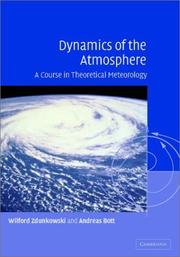
ISBN: 110713188X 0511078056 1282387065 0511643225 9786612387067 0511805462 0511202954 0511561504 0511076487 9780511078057 9780511076480 9780511805462 9780511202957 0521809495 9780521809498 052100666X 9780521006668 Year: 2003 Publisher: Cambridge, UK New York Cambridge University Press
Abstract | Keywords | Export | Availability | Bookmark
 Loading...
Loading...Choose an application
- Reference Manager
- EndNote
- RefWorks (Direct export to RefWorks)
Dynamics of the Atmosphere consists of two parts: the first presenting the mathematical tools needed for a thorough understanding of the topics covered in the second part of the book. The second part begins with the derivation of the equation describing the atmospheric motion on the rotating earth. Subjects tackled in subsequent chapters include kinematics of the atmosphere (including vorticity and circulation theorems), wave motion in the atmosphere, inertial and dynamic stability, and turbulent systems in the atmosphere. Finally, newer methods of weather prediction, such as the spectral technique and the stochastic dynamic method, are introduced in order to demonstrate their potential for extending the forecasting range. Complete with numerous exercise sets and solutions, this textbook has been written for advanced undergraduate and graduate students of meteorology and other related sciences. It may also be used as a reference source by professional meteorologists and researchers in atmospheric science.
Meteorology. --- Aerology --- Atmospheric science
Book
ISBN: 3038422851 Year: 2016 Publisher: Basel, Switzerland : MDPI,
Abstract | Keywords | Export | Availability | Bookmark
 Loading...
Loading...Choose an application
- Reference Manager
- EndNote
- RefWorks (Direct export to RefWorks)
The composition of the atmosphere is a critical factor in understanding the nature and magnitude of processes associated with the planet's energy balance, clouds and precipitation, biogeochemical cycling of nutrients, and public health and welfare. A detailed understanding of trace gases, aerosol particles, and hydrometeors is challenging due to the combination of their physicochemical complexity, variable lifetimes, and spatial inhomogeneity. Recent advances in instrumentation have resulted in improved measurements and an increased understanding of atmospheric composition. Laboratory and field in-situ measurement studies have benefited from such improvements, including improved spatial and temporal resolution, the ability to sample in challenging conditions (e.g., on airborne platforms, in clouds, at widely ranging pressure and temperature conditions), and the ability to measure a wider range of chemical species, and, in the case of aerosol particles, to detect smaller sizes. Remote sensing capabilities have increased in recent years, thus offering new views of atmospheric composition across broad spatiotemporal ranges. Manuscripts related to all aspects of atmospheric observations are included in this Special Issue, including advances in observational techniques and scientific insights into atmospheric composition.
Meteorology. --- Aerology --- Atmospheric science
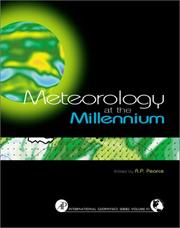
ISBN: 0125480350 9786611144821 1281144827 008051149X 9780080511498 9780125480352 9781281144829 661114482X Year: 2002 Volume: 83 Publisher: San Diego Academic Press
Abstract | Keywords | Export | Availability | Bookmark
 Loading...
Loading...Choose an application
- Reference Manager
- EndNote
- RefWorks (Direct export to RefWorks)
Meteorology at the Millennium details recent advances in meteorology and explores its interfaces with science, technology, and society. Ways in which modern meteorology is contributing to the developments in other sciences are described, as well as how atmospheric scientists are learning from colleagues in related disciplines.Meteorology at the Millennium will serve as a point of reference for students and researchers of meteorology and climatology for many years to come.The areas covered include weather prediction at the millennium, climate variability and change
Meteorology --- Meteorology. --- Aerology --- Atmospheric science
Book
ISBN: 1283848201 0810886138 9780810886131 9781283848206 9780810886124 081088612X Year: 2013 Publisher: Lanham, Md. : Scarecrow Press,
Abstract | Keywords | Export | Availability | Bookmark
 Loading...
Loading...Choose an application
- Reference Manager
- EndNote
- RefWorks (Direct export to RefWorks)
The Handbook of Meteorology gives specialists and non-specialists alike a clear understanding of the way our weather functions. It is a comprehensive reference for any budding meteorologist or environmental professional in the field, laboratory, or classroom.
Meteorology --- Meteorology. --- Aerology --- Atmospheric science
Book
ISBN: 9535152491 9535103369 Year: 2012 Publisher: IntechOpen
Abstract | Keywords | Export | Availability | Bookmark
 Loading...
Loading...Choose an application
- Reference Manager
- EndNote
- RefWorks (Direct export to RefWorks)
Phenology, a study of animal and plant life cycle, is one of the most obvious and direct phenomena on our planet. The timing of phenological events provides vital information for climate change investigation, natural resource management, carbon sequence analysis, and crop and forest growth monitoring. This book summarizes recent progresses in the understanding of seasonal variation in animals and plants and its correlations to climate variables. With the contributions of phenological scientists worldwide, this book is subdivided into sixteen chapters and sorted in four parts: animal life cycle, plant seasonality, phenology in fruit plants, and remote sensing phenology. The chapters of this book offer a broad overview of phenology observations and climate impacts. Hopefully this book will stimulate further developments in relation to phenology monitoring, modeling and predicting.
Meteorology. --- Aerology --- Atmospheric science --- Meteorology & climatology
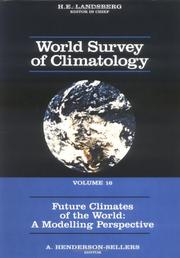
ISBN: 9780444893222 0444893229 9780080532233 0080532233 9786611072674 1281072672 Year: 1995 Publisher: Amsterdam ; New York : Elsevier,
Abstract | Keywords | Export | Availability | Bookmark
 Loading...
Loading...Choose an application
- Reference Manager
- EndNote
- RefWorks (Direct export to RefWorks)
Future Climates of the World: A Modelling Perspective is Volume 16 of the highly prestigious series of climatology reference books World Survey of Climatology. The present volume offers a state-of-the-art overview of our understanding of future climates and is aimed at climatology undergraduates, interested non-climatologists with a scientific background as well as the generally interested reader. Each topic is discussed clearly so that the full implications of its affect on the earth's future climate can be fully understood. The study of climate has moved from data collect
Climatology --- Meteorology. --- Aerology --- Atmospheric science --- Mathematical models.
Book
ISBN: 867131040X Year: 1990 Publisher: Ljubljana Slovenska akademija znanosti in umetnosti v Ljubeljani in Društvo meteorologov Slovenije
Abstract | Keywords | Export | Availability | Bookmark
 Loading...
Loading...Choose an application
- Reference Manager
- EndNote
- RefWorks (Direct export to RefWorks)
Meteorology --- -Aerology --- Earth sciences --- Atmosphere --- Dictionaries --- -Slovenian --- -Dictionaries --- Aerology --- Dictionaries&delete& --- Slovenian --- Atmospheric science
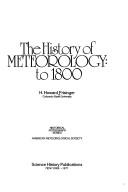
ISBN: 0882020366 9780882020365 Year: 1977 Publisher: New York (N.Y.): Science history publications,
Abstract | Keywords | Export | Availability | Bookmark
 Loading...
Loading...Choose an application
- Reference Manager
- EndNote
- RefWorks (Direct export to RefWorks)
Meteorology --- History --- -Aerology --- Earth sciences --- Atmosphere --- -History --- Meteorology - History
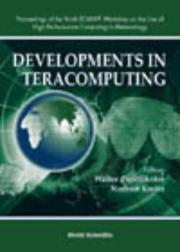
ISBN: 1281948004 9786611948009 9812799680 9789812799685 9781281948007 9789810247614 9810247613 6611948007 Year: 2001 Publisher: Singapore River Edge, N.J. World Scientific
Abstract | Keywords | Export | Availability | Bookmark
 Loading...
Loading...Choose an application
- Reference Manager
- EndNote
- RefWorks (Direct export to RefWorks)
Meteorology --- Earth sciences --- Aerology --- Atmospheric science --- Data processing
| Listing 1 - 10 of 245 | << page >> |
Sort by
|

 Search
Search Feedback
Feedback About UniCat
About UniCat  Help
Help News
News